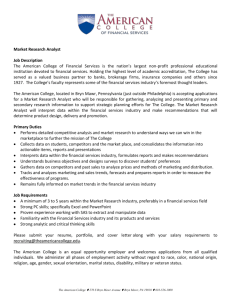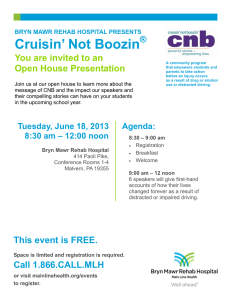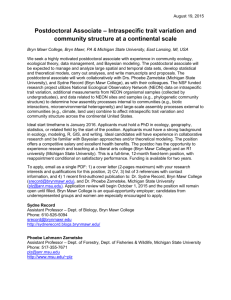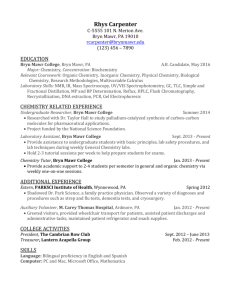Bryn Mawr College Physics 2007 Newsletter
advertisement
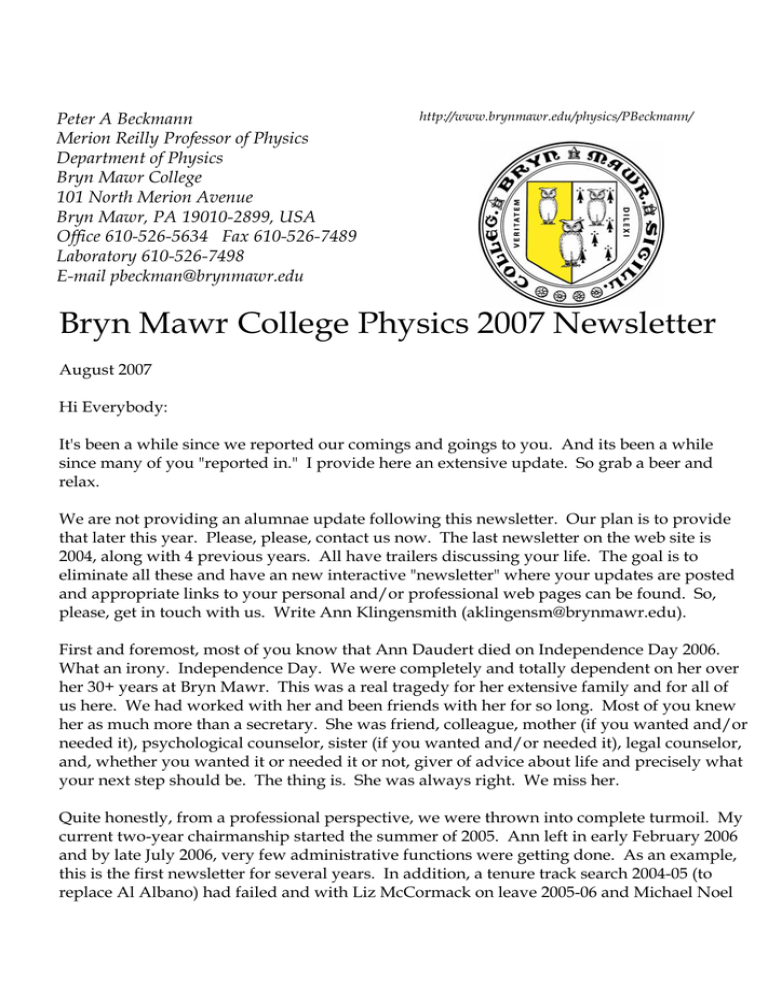
Peter A Beckmann Merion Reilly Professor of Physics Department of Physics Bryn Mawr College 101 North Merion Avenue Bryn Mawr, PA 19010-2899, USA Office 610-526-5634 Fax 610-526-7489 Laboratory 610-526-7498 E-mail pbeckman@brynmawr.edu http://www.brynmawr.edu/physics/PBeckmann/ Bryn Mawr College Physics 2007 Newsletter August 2007 Hi Everybody: It's been a while since we reported our comings and goings to you. And its been a while since many of you "reported in." I provide here an extensive update. So grab a beer and relax. We are not providing an alumnae update following this newsletter. Our plan is to provide that later this year. Please, please, contact us now. The last newsletter on the web site is 2004, along with 4 previous years. All have trailers discussing your life. The goal is to eliminate all these and have an new interactive "newsletter" where your updates are posted and appropriate links to your personal and/or professional web pages can be found. So, please, get in touch with us. Write Ann Klingensmith (aklingensm@brynmawr.edu). First and foremost, most of you know that Ann Daudert died on Independence Day 2006. What an irony. Independence Day. We were completely and totally dependent on her over her 30+ years at Bryn Mawr. This was a real tragedy for her extensive family and for all of us here. We had worked with her and been friends with her for so long. Most of you knew her as much more than a secretary. She was friend, colleague, mother (if you wanted and/or needed it), psychological counselor, sister (if you wanted and/or needed it), legal counselor, and, whether you wanted it or needed it or not, giver of advice about life and precisely what your next step should be. The thing is. She was always right. We miss her. Quite honestly, from a professional perspective, we were thrown into complete turmoil. My current two-year chairmanship started the summer of 2005. Ann left in early February 2006 and by late July 2006, very few administrative functions were getting done. As an example, this is the first newsletter for several years. In addition, a tenure track search 2004-05 (to replace Al Albano) had failed and with Liz McCormack on leave 2005-06 and Michael Noel Physics at Bryn Mawr 2007 2 on leave 2006-07, we have had too few folks "in house" since June 2005. (Recovery is on the way! See below.) Its not that we are incompetent administrators. (Well, maybe it is.) The point is that Ann Daudert had done so much for so long, much without seeking thanks or compliments, that we had no idea what we were not doing until somebody told us it should have been done. We are building a Tribute Garden in memory of deceased long-serving Park faculty and staff. It will be in the inner court yard of Park where we have picnics. Although it will honor others who have died over the years, it was driven by Ann Daudert's many friends at Bryn Mawr and beyond. There will be plants and bushes, benches in the garden, and a plaque with the names of those being memorialized. Please feel free to seek additional information about this from me or from Ann Klingensmith. We were delivered from eternal damnation by Ann Klingensmith who joined us late August 2006. Ann is a tireless worker and makes my organizational skills look like Al Albano's. Of course there was no training per se since most knowledge was lost to oblivion. We offer a huge thanks to Betsy Cancelliere, the Math secretary and to Kim McConnell, the financial secretary in the Biology-Chemistry-Geology Office who did what they could for the hopeless physicists February to August 2006 when we were rudderless and to help Ann Klingensmith from August 2006 to the present. Ann has now completed almost one full year with us and it appears we are completely on track . . . . . and once again the faculty are entering that wonderful state of hopeless dependence. It was meant to be. And you can now send Ann your life update. She's ready to rock'n'roll. So, we thank Ann Klingensmith for saving us and we welcome her to the Physics Department and to the Computer Science Department. The office is now formally shared by both departments and Ann is the secretary to both departments. The Physics/Computer Science office was partially renovated in January 2007 with a rug, new paint, and all new furniture. So, it's quite a nice place for Ann Klingensmith to work. Alas, Al Albano really did retire. The rumor is true. I worked with Al for 30 years and it's a real personal loss for me. Officially, he retired at the end of the 2004-05 academic year but his last full year of teaching was 2003-04 since his last year was a leave year. He is around now-and-again and is, of course, quite active in a variety of research and educational pursuits. We got him to teach a graduate course 2005-06 but he really did say "no" for 200607. He has two grandchildren in the San Francisco area so he and Connie are there a lot. He spent some time in Singapore a year ago and he and Connie visit the Philippines once in a while. The last few years have been both exciting and hectic for me. I took on the chairmanship for a 2005-2007 term so I am just stepping down. I have chaired the department for 10 of my 30 Physics at Bryn Mawr 2007 3 years. What's worse, I've chaired the department for 8 of the last 14 years. That's not fair, is it? There ain't no justice. In 1996 I joined a very active group in the Chemistry Department at the University of Delaware which is about an hour away if the wind is right. I am able to do sophisticated solid state nuclear magnetic resonance experiments with very competent technicians to help me out. With the head of that lab I have a two-institution NSF grant (2004-2007). We are learning how lattice vibrations interact with nuclear spins in heavymetal ionic solids. We do lead, cadmium, mercury, and tin dynamical nuclear magnetic resonance. At Bryn Mawr I continue a very productive collaboration with Frank Mallory in Chemistry (who, at 74, shows absolutely no sign of slowing down). We study the reorientational dynamics of atomic groups in Van der Waals solids composed of covalently bonded molecules. I continue to think that having a job where I am allowed to combine engaging research and teaching students like you is a real privilege. I was 60 in March 2007 so I have spent half my life at Bryn Mawr College. And I ain't going nowhere nohow. I'm having too much fun. The last few years have also been very exciting for Liz McCormack, who joined our ranks 12 years ago in 1995. Most recently, Liz and her students have been very successful investigating very highly excited states of hydrogen. She had two back-to-back large NSF grants that spanned an eight -year period and she currently has a NASA Advanced Concept grant. Liz is very active in the profession at many levels. She was elected as a Fellow to the American Physical Society in 2005 and this is a real honor. It speaks to both to the research she has done at Bryn Mawr College and to her involvement with promoting physics research at liberal arts colleges nationwide. In addition to attending many research meetings, Liz is active in Project Kaleidoscope and the American Physical Society. She is currently serving on the APS Committee on Education, the Executive Committee of the Division of Atomic, Molecular and Optical Physics, and the Advisory Board of Research Corporation. Liz was chair of the Physics Department 2002-05 and she was promoted to Full Professor in 2005. Finally, Liz was recently elected to the position of Chair of the General Faculty at Bryn Mawr College. This is a new position that comes from our new and very much revised Faculty ByLaws. Liz now chairs faculty meetings, ending many decades of the President chairing faculty meetings. She also chairs an Advisory Committee where the chairs of the important faculty committees come together to discuss issues of faculty governance. If Bryn Mawr College had a senate like many institutions do (but which we don't), Liz would be President of the Senate. On behalf of all of you, I heartily congratulate Liz on all her accomplishments. Michael Noel, who joined us in 2000, was recently tenured and promoted to Associate Professor in September 2006. Michael was just awarded his second major three-year National Science Foundation Grant. Mike traps small numbers of atoms in a state where the translational temperature is less than a millikelvin and he can do laser spectroscopy on a time scale very short compared with the collision time. So, even though the trapped gas is very dilute, it behaves somewhat like an amorphous solid, but on a greatly magnified scale. Physics at Bryn Mawr 2007 4 He and his students trap rubidium atoms with six laser beams and a magnetic field, then excite them to very highly excited states with other laser beams, then put them in an electric field to create an induced electric dipole that allows them to interact and exchange energy. Mike was on leave 2006-07 but he is taking over the chairmanship for a 2007-10 term. So, over the summer I am transferring all the department's administration to him. It's wonderful! Mike was also just elected to the Committee on Academic Priorities, which reviews and makes decisions on future faculty positions. Mark Matlin joined us in 2003. Mark gave up a tenure-track Assistant Professorship at Sarah Lawrence to come to Bryn Mawr as a Senior Laboratory Coordinator/Senior Lecturer. Now that must say something about us! Mark and Bryn Mawr Physics go way way back, and some of you will remember him from the 1990s. This included part-time positions at Bryn Mawr and Haverford; 1990-93 and 1995-97. Although Mark's primary responsibility is the introductory labs, he can and does teach at all levels, including graduate courses. Mark's PhD is in general relativity but he also did the equivalent of a post-doc in experimental quantum optics with Neal Abraham at Bryn Mawr in the late 1980's and early 1990's. He also held an NIH postdoc at the Neuroengineering Laboratory at the University of Pennsylvania, focusing on computer models of primate visual systems, research which he continues today. So, he is a very valuable member of our enterprise. For the last two years, we have been exceptionally lucky to have David Nice, a radio astronomer, as a Visiting Assistant Professor. David will also be here for the 2007-08 season. David was at Princeton for several years. He studies pulsars⎯rapidly rotating neutron stars, which are detected as pulses of radio waves. These pulses serve as a sort of cosmic clock, and by measuring them with extraordinary precision, David and his students can simultaneously learn a lot about the interstellar medium, study high density nuclear matter, and, using binary pulsar systems, perform fundamental tests of general relativity. Please check out his web site, accessible from our site. David has brought a very important set of teaching experiences to our department, and he has been an active player in our foreverevolving curriculum. Matthew Rice taught in our department for four years from 1998 to 2004 so many of you will remember him. Well, he's still at Bryn Mawr! In 2004 he switched from "faculty" to "staff." He is the "Systems Administrator for the Sciences." (Compujocks get such neat titles, don't they?) What this means in practice is that he in the LINUX/UNIX person for the Natural Sciences, mainly Park. However, his wife, Associate Professor of Psychology Anjali Thapar, sometimes summons him "up the hill" to tend to the Psychologists. We are fortunate to have such a competent "staff" member in Park Sciences. Of course, I need him when I have questions about quantum field theory or magnetic monopoles in the early universe. Matt teaches in Physics occasionally to keep his physics feet wet and last semester he taught the sophomore electronics lab. Physics at Bryn Mawr 2007 5 We are thrilled to announce that following an exhausting tenure track search during the 2006-07 season, Michael Schulz will join us late August 2007. Please have a look at his web site which is now available from our departmental site. You will learn that his work focuses on string theory and its applications to quantum field theory, cosmology and particle physics. Mike's recent research has explored the interplay between discrete data that enter into string theory solutions (for example, magnetic fluxes and topological twists in the extra dimensions), and the corresponding macroscopic data relevant to particle physics. He did his BS at MIT, his MS at UC Berkeley, his PhD at Stanford, a post-doc at Caltech, and a postdoc at Penn. Phew! We are very excited. So, I said earlier that we've had a few rough years because we have been short of folks but beginning 2007-08, we are looking forward to an active, exciting, and involved group of faculty members. As such, surely its time to redo the curriculum . . . . . . again! Let me tell you about some exciting undergraduate course initiatives. In 2004-05 and 2005-06, Mike Noel developed and taught "How Things Work." In 2006-07, I developed and taught "How Physicists Model the World." These two complementary courses were very popular among humanities and social science students and the enrollments were in the high 30's to high 40's. Mike's course had many demonstrations and dealt mainly with everyday phenomenon. My course, dealt with physics outside the normal human realm (relativity, quantum mechanics, etc.). Others in the department are going to develop "their" courses so we can offer a course that connects non-science students to physics every year. As I am sure you know, our society is not doing well in the science education business. These courses offer physics with little or no mathematics. The students love these courses so maybe they won't tell their children scary science stories. In 2004-05, we completely "redid" the introductory physics labs. We essentially emptied the two big rooms and started over again. Rather than everybody doing the same experiment every week, we put a different experiment on each desk. The experiments stay put for a semester and the students cycle through them. We've had some growing pains but we've done it for three years now and everybody thinks its a big improvement. People may have a variety of opinions but very few of the 150 or so students in this lab each semester think its boring. As most of you know all too well, we mess with the first two years of the curriculum every decade or so. (The "standard" third and fourth-year courses never appear to change if you just look at their titles and numbers, but, of course, their content varies greatly to address new discoveries and paradigms in physics.) So, we're in the midst of doing this again. We are going to do a four-year sequence where I is "an introduction to physics" (but requiring Physics at Bryn Mawr 2007 6 calculus I as a corequisite), II is newtonian and relativistic mechanics (requiring calculus II), III is electromagnetism and optics (requiring multivariable calculus), and IV is waves and quantum mechanics (requiring linear algebra). Sound familiar? Well, thanks for listening. If you want more information about the Tribute Garden in memory of Ann Daudert, please contact me or Ann Klingensmith. And please let us know what's going on in your life. Yours truly, Peter Beckmann
